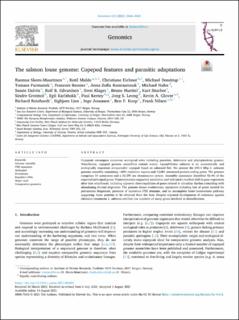| dc.contributor.author | Skern-Mauritzen, Rasmus | |
| dc.contributor.author | Malde, Ketil | |
| dc.contributor.author | Eichner, Christiane | |
| dc.contributor.author | Dondrup, Michael | |
| dc.contributor.author | Furmanek, Tomasz | |
| dc.contributor.author | Besnier, Francois | |
| dc.contributor.author | Komisarczuk, Anna Zofia | |
| dc.contributor.author | Nuhn, Michael | |
| dc.contributor.author | Dalvin, Sussie | |
| dc.contributor.author | Edvardsen, Rolf Brudvik | |
| dc.contributor.author | Klages, Sven | |
| dc.contributor.author | Huettel, Bruno | |
| dc.contributor.author | Stueber, Kurt | |
| dc.contributor.author | Grotmol, Sindre | |
| dc.contributor.author | Karlsbakk, Egil Erlingsson | |
| dc.contributor.author | Kersey, Paul | |
| dc.contributor.author | Leong, Jong S | |
| dc.contributor.author | Glover, Kevin Alan | |
| dc.contributor.author | Reinhardt, Richard | |
| dc.contributor.author | Lien, Sigbjørn | |
| dc.contributor.author | Jonassen, Inge | |
| dc.contributor.author | Koop, Ben F | |
| dc.contributor.author | Nilsen, Frank | |
| dc.date.accessioned | 2021-09-29T08:49:56Z | |
| dc.date.available | 2021-09-29T08:49:56Z | |
| dc.date.created | 2021-08-30T13:19:19Z | |
| dc.date.issued | 2021 | |
| dc.identifier.citation | Genomics. 2021, 113 (6), 3666-3680. | en_US |
| dc.identifier.issn | 0888-7543 | |
| dc.identifier.uri | https://hdl.handle.net/11250/2785927 | |
| dc.description.abstract | Copepods encompass numerous ecological roles including parasites, detrivores and phytoplankton grazers. Nonetheless, copepod genome assemblies remain scarce. Lepeophtheirus salmonis is an economically and ecologically important ectoparasitic copepod found on salmonid fish. We present the 695.4 Mbp L. salmonis genome assembly containing ≈60% repetitive regions and 13,081 annotated protein-coding genes. The genome comprises 14 autosomes and a ZZ-ZW sex chromosome system. Assembly assessment identified 92.4% of the expected arthropod genes. Transcriptomics supported annotation and indicated a marked shift in gene expression after host attachment, including apparent downregulation of genes related to circadian rhythm coinciding with abandoning diurnal migration. The genome shows evolutionary signatures including loss of genes needed for peroxisome biogenesis, presence of numerous FNII domains, and an incomplete heme homeostasis pathway suggesting heme proteins to be obtained from the host. Despite repeated development of resistance against chemical treatments L. salmonis exhibits low numbers of many genes involved in detoxification. | en_US |
| dc.language.iso | eng | en_US |
| dc.title | The salmon louse genome: Copepod features and parasitic adaptations | en_US |
| dc.type | Peer reviewed | en_US |
| dc.type | Journal article | en_US |
| dc.description.version | publishedVersion | en_US |
| dc.source.pagenumber | 3666-3680 | en_US |
| dc.source.volume | 113 | en_US |
| dc.source.journal | Genomics | en_US |
| dc.source.issue | 6 | en_US |
| dc.identifier.doi | 10.1016/j.ygeno.2021.08.002 | |
| dc.identifier.cristin | 1929779 | |
| cristin.ispublished | true | |
| cristin.fulltext | original | |
| cristin.qualitycode | 1 | |
